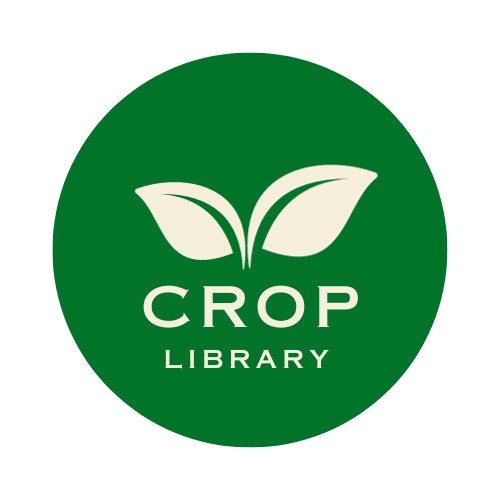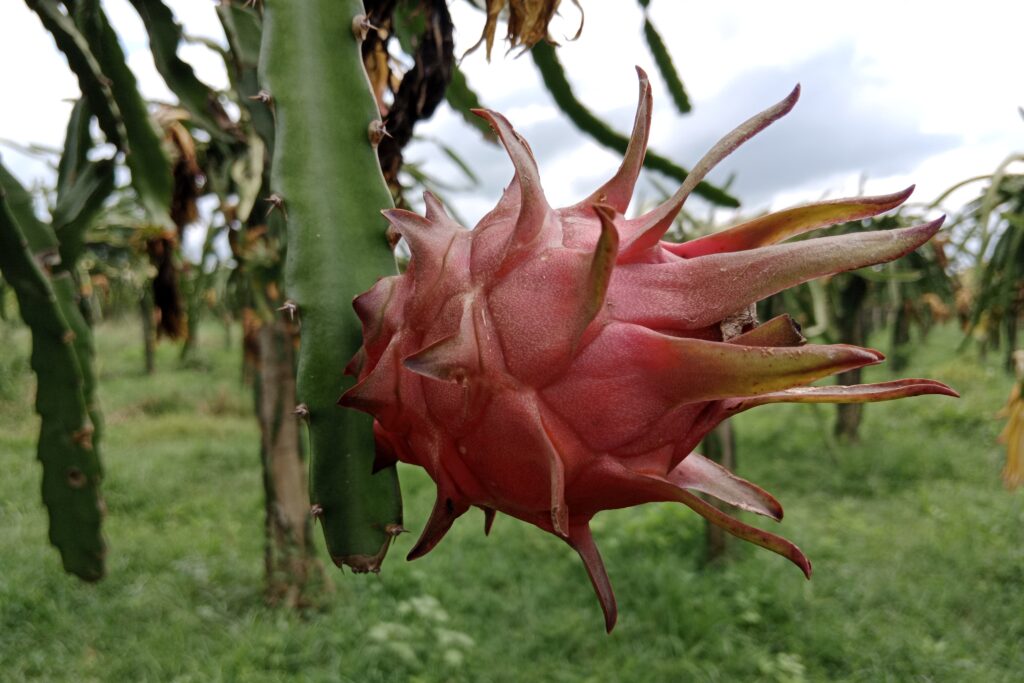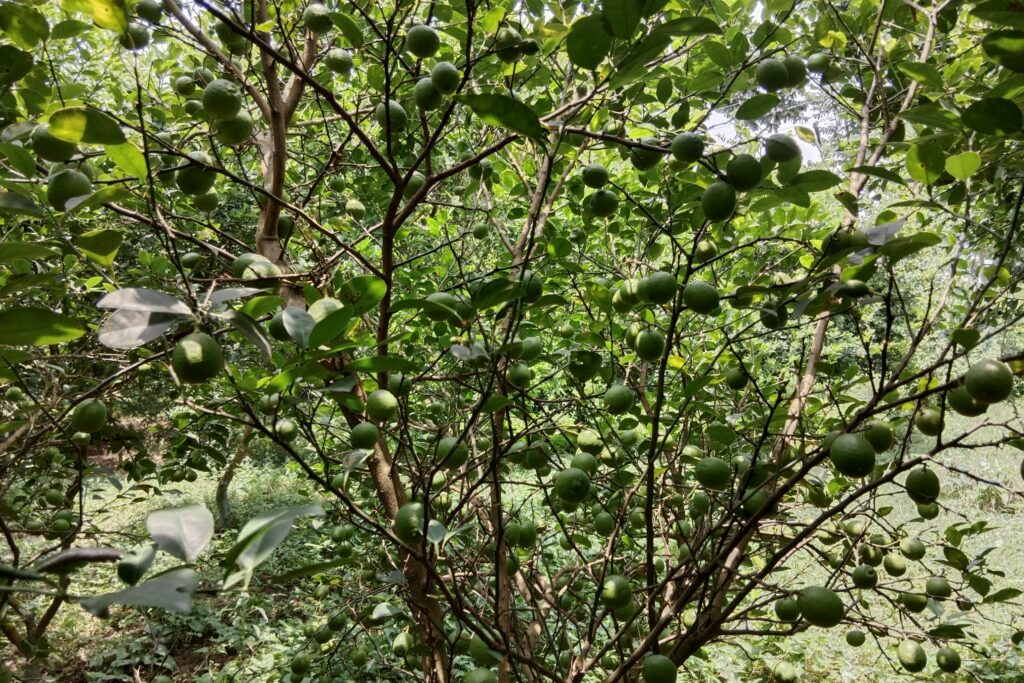Kiwi Farming
The kiwi farming profit per acre demonstrates a high return on investment, as the total income significantly exceeds the initial and ongoing costs, resulting in a substantial net profit. The income exhibits a clear growth pattern, beginning with gradual increases during the early years (Years 3–5), stabilizing at a peak level from Years 6–15, and experiencing a slight decline in the later years (Years 16–25).
The initial investment for kiwi farming profit per acre is NRs. 579,500, covering expenses such as land preparation, saplings, trellis setup, irrigation, and other essential costs. Over a 25-year period, the total income generated amounts to NRs. 20,520,000, leading to an average annual profit of NRs. 725,620. This underscores the strong financial potential and profitability of kiwi farming profit per acre.

Furthermore, the enterprise demonstrates sustainability, with consistent maintenance costs and significant income generation during the peak productive years (Years 6–15), resulting in a substantial financial surplus. The kiwi farming profit per acre model is not only highly profitable but also resilient, making it a promising option for farmers aiming for stable and high-yielding agricultural ventures.
Land Preparation
The first step in preparing the land for planting is to remove any rubbish, rocks, and weeds to make the area clear and unobstructed. In order to optimize root penetration, soil aeration, and soil structure, the soil is then broken up into a fine, crumbly texture by plowing and harrowing.
For plants to thrive on a healthy foundation, several procedures are essential. In order to guarantee even water distribution during irrigation and avoid dry spots or waterlogging, the field is finally leveled. A successful and fruitful growing process is facilitated by this careful preparation, which creates the ideal conditions for plant growth and development.
Soil Type
Kiwifruit plants require specific soil and sunlight conditions to thrive. They perform best when exposed to full sunlight for at least 6–8 hours daily, as this is crucial for maximizing photosynthesis and ensuring healthy fruit production.
When it comes to soil, kiwifruit thrives on fertile, well-drained soils that have a pH between 5.5 and 7.0. Because loamy soils offer a harmonious blend of enough moisture retention, appropriate drainage, and good aeration—all critical for the best possible plant growth—they are regarded as perfect.
However, as they tend to hold too much water and limit root growth, thick clay soils should be avoided. Furthermore, the amount of calcium carbonate (CaCO3) in the soil should not exceed 10% since larger concentrations might hinder the uptake of nutrients, especially resulting in iron deficiencies, which can negatively affect the productivity and health of plants.
Climatic Requirements
Kiwi plants grow best in temperate climates, where the temperature typically ranges between 14°C and 24°C. However, young plants are particularly vulnerable to frost, so protective measures, such as frost covers or windbreaks, are necessary in areas prone to freezing temperatures.
In terms of moisture, kiwi plants require consistent and adequate water supply. Regions with an annual rainfall of 1500–2000 mm are ideal for their growth. In drier areas, irrigation systems must be implemented to ensure the plants receive sufficient moisture, as maintaining proper hydration is critical for healthy development and fruit production.
Major Cultivars
Below is a detailed table of some popular kiwi cultivars, highlighting their key characteristics:
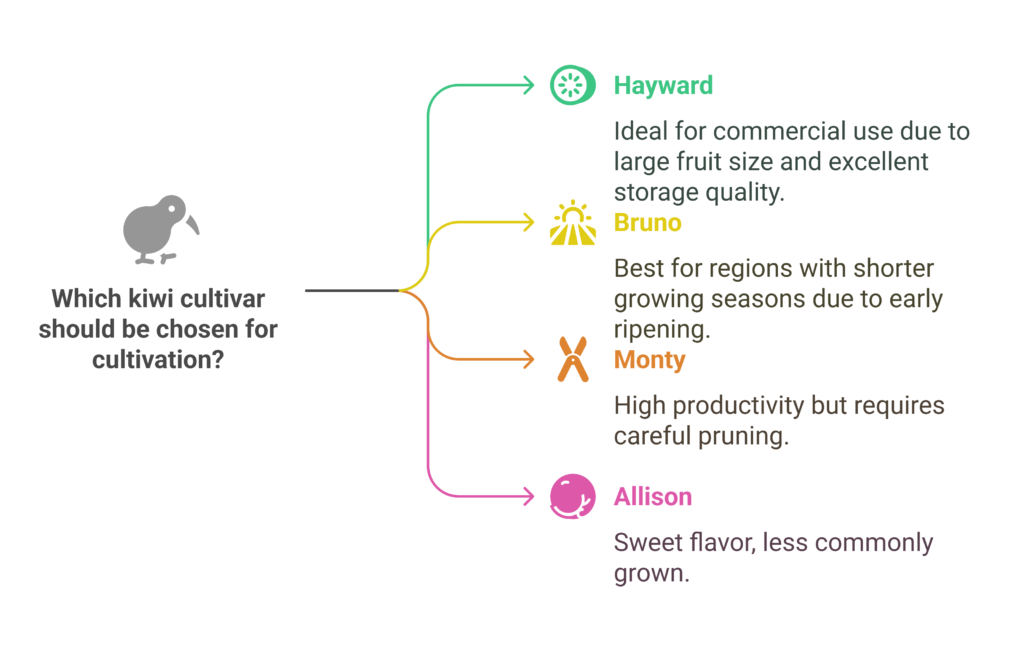
| Cultivar | Key Characteristics |
| Hayward | · Most widely grown cultivar globally. · Known for its large fruit size. · Excellent storage quality, making it ideal for commercial use. |
| Bruno | · Produces cylindrical-shaped fruits. · Known for its early ripening. · Suitable for regions with shorter growing seasons. |
| Monty | · Yields medium to large-sized fruits. · Known for its high productivity. · Requires careful pruning to manage vigorous growth. |
| Allison | · Produces oval-shaped fruits. · Known for its sweet flavor. · Less commonly grown compared to Hayward. |
| Hayward Oblong | · A variant of Hayward with oblong-shaped fruits. · Retains the excellent storage quality of Hayward. |
| Hayward Oval | · Another variant of Hayward with oval-shaped fruits. · Popular for its uniform fruit size and shape. |
| Red Kiwi | · Known for its unique red flesh. · Offers a distinct flavor profile. · Gaining popularity in niche markets. |
Planting
Below is a detailed for planting kiwi vines:
| Aspect | Details |
| Trellis Support | · Use T-bars made of 2.5–3 m long iron posts. · 1.8 m above ground, 60–70 cm buried. · Horizontal arms extend 1–1.2 m. · Space T-bars 4.5 m apart. · String galvanized wires tightly between bars for trellis structure. · Reinforce end posts with 4–5 wires for stability. · Position plants 0.6 m away from T-bars for proper growth. |
| Planting Season | · Plant during dormancy (late winter or early spring). · Minimizes transplant shock. · Allow roots to establish before warmer months. |
| Spacing | · 6 meters between plants. · 5 meters between rows. |
| Pit Preparation | · Dig pits of 1 m x 1 m x 1 m. · Fill with a mixture of topsoil and 20–30 kg compost manure. |
| Planting Method | · Plant saplings in the center of the pits. · Ensure roots are well-spread and covered with soil. |
| Plants per Acre | · Approximately 135 plants per acre, depending on spacing. |
Intercropping
Intercropping in kiwi farming is a strategic practice that involves cultivating compatible crops alongside kiwi vines to optimize land use, improve soil health, and boost overall farm productivity. This method offers numerous benefits, such as enhancing soil fertility through nitrogen-fixing legumes like beans or clover, suppressing weeds with cover crops, and managing pests using repellent plants like marigolds or garlic.
Additionally, intercropping with short-duration crops like leafy greens or herbs can provide supplementary income. Suitable intercrops include legumes, vegetables, herbs, flowers, and cover crops, which not only improve soil structure but also help regulate the microclimate by conserving moisture and reducing soil erosion. By integrating these crops, farmers can create a more sustainable and diversified farming system.
To prevent competition for vital resources like sunlight, water, and nutrients, intercropping must be carefully planned and managed. Maintaining appropriate spacing, choosing intercrops with short growth cycles and shallow root systems, and modifying irrigation and fertilizing techniques to accommodate the requirements of both kiwi vines and intercrops are important factors.
Potential resource rivalry, more complex management, and harvesting challenges are some of the drawbacks of intercropping. Despite these difficulties, intercropping can be a very profitable and sustainable tactic if done carefully. It is a useful technique for farmers seeking to accomplish long-term agricultural sustainability since it improves soil health, lowers input costs, and increases kiwi orchard yield.
Irrigation
Irrigation plays a vital role in kiwi farming, ensuring healthy growth and maximizing fruit yield, with drip irrigation being the most efficient method. The water needs of kiwi plants vary based on their age, growth stage, and environmental factors. Below is the details about the water required by kiwi plants:
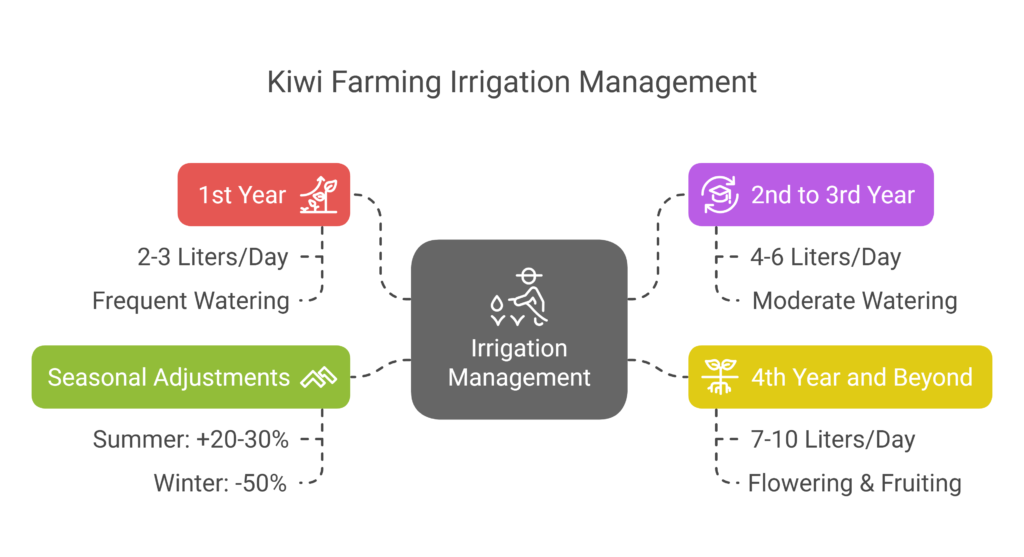
a). 1st Year
Young kiwi plants require 2–3 liters of water per tree per day. Frequent and light watering is essential to help establish strong root systems during this critical growth phase.
b). 2nd to 3rd Year
The plants require 4–6 liters of water per tree every day as they become bigger and their root systems spread out. Watering plants moderately promotes the development of their structure and guarantees healthy growth.
c). 4th Year and Beyond
Mature kiwi plants demand 7–10 liters of water per tree per day, particularly during the flowering and fruiting stages when water is crucial for optimal yield and quality.
d). Seasonal Adjustments
During summer, water requirements for kiwi plants increase by 20–30% above the normal daily levels to compensate for higher evaporation rates and heat-induced plant stress. In contrast, during winter, watering should be reduced by 50% of the normal levels to prevent waterlogging and root rot, as the plants enter their dormancy period.
Adhering to this irrigation schedule ensures the efficient use of water resources while maintaining the health and productivity of kiwi plants.
Fertilizer and Manure
A healthy kiwi crop depends on the supply of key micronutrients like magnesium, boron, and zinc. Soil application or foliar spraying are two ways to supply these nutrients. Vermicompost, neem cake, and bone meal are organic substitutes for chemical fertilizers in organic kiwi farming. To guarantee ideal plant development and fruit production, the same nutrient balance must be maintained.
Fertilizer Requirements by Plant Age
a). 1st Year
The focus during the first year is on root establishment. Fertilizers should be applied in split doses to avoid nutrient loss and ensure effective absorption.
Nitrogen: 50–100 g
Phosphorus: 25–50 g
Potassium: 50–100 g
Organic Manure: 10–15 kg
b). 2nd Year
As the plant grows, fertilizer requirements increase. It is recommended to apply fertilizers in 3 split doses (March, June, and October) annually to support the growing plant.
Nitrogen: 150–200 g
Phosphorus: 75–100 g
Potassium: 150–200 g
Organic Manure: 15–20 kg
c). 3rd Year
During the third year, fertilizers should be balanced to support vigorous vegetative growth. Ensuring an adequate nutrient supply is essential for the plant’s overall development.
Nitrogen: 250–300 g
Phosphorus: 100–150 g
Potassium: 250–300 g
Organic Manure: 20–25 kg
d). 4th Year and Beyond (Mature Plants)
Mature kiwi plants have higher nutrient demands, especially during flowering and fruiting stages. Fertilizers should be applied in split doses to meet these demands and enhance fruit yield and quality.
Nitrogen: 500–600 g
Phosphorus: 200–250 g
Potassium: 500–600 g
Organic Manure: 25–30 kg
Weed Management in Kiwi Cultivation
| Stage | Method | Details |
| Before Planting | Soil Cultivation | Cultivate the soil, irrigate to germinate new weeds, and cultivate again to reduce weed seed population. Repeat at least twice to minimize annual weeds. Less effective for perennial weeds if the soil remains moist. |
| Perennial Weed Control | For weeds like dallisgrass, bermudagrass, and johnsongrass, cultivate dry soil to cut rhizomes into small pieces and dry them out. Repeat the process to desiccate new rhizomes. Avoid irrigation or rain before complete control to prevent re-rooting and increased weed populations. Remove seedlings promptly after irrigation or rainfall. | |
| Herbicide Use | Preemergence herbicides are not registered for kiwifruit vineyards before planting. Use postemergence herbicides like glyphosate followed by cultivation as a safer option. | |
| Fumigation | Fumigants like metam sodium (Vapam) can be applied to control weeds and soilborne pests effectively when used correctly. | |
| After Planting | Mulching | Mulching with black polypropylene prevents weed germination while allowing water penetration. Some growers limit mulch to smaller areas under emitters to save costs. |
| Cultivation and Hoeing | Frequent hoeing or cultivation between rows reduces weed competition and prevents weeds from seeding. | |
| Herbicide Use | Apply herbicides in a 4–6-foot strip under the vine row to reduce weed competition and rodent damage. Preemergence herbicides are safe for established vines to control annual and some perennial weed seedlings. Postemergence herbicides can be used alone or combined with pre-emergence options for existing weeds. Spot applications may be needed for perennials. | |
| Precautions | Avoid herbicide contact with vines to prevent injury. |
Pest and Disease Management
Common Pests in Kiwi Cultivation
| Pest | Damage Symptoms | Natural Enemies |
| a) Brown-headed Leaf Roller | Webbing together of leaf edges or leaves and fruit to form shelters, often rolling leaves into a tube. Caterpillars feed on both leaves and fruit. | Predators: Predatory mites, wasps. Larval parasitoids: Trigonospila brevifacies, Braconid wasps, Dolichogenidea tasmanica, Goniozus jacintae. |
| b) Green-headed Leaf Roller | Webbing together of leaf edges or leaves and fruit to form shelters, often rolling leaves into a tube. Caterpillars feed on both leaves and fruit. | Predators: Predatory mites, wasps. Larval parasitoids: Trigonospila brevifacies, Braconid wasps, Dolichogenidea tasmanica, Goniozus jacintae. |
| c) Greedy Scale | Infestations spread by mobile young scale nymphs (“crawlers”), while older nymphs and adults remain sedentary. Scales attack bark and fruit, reducing plant vigor and causing off-grade fruit quality. | Parasitoids: Aphytis wasps, Encarsia species. Predators: Green lacewings, minute pirate bugs, ladybird beetles, Chilocorus bipustulatus, Chilocorus infernalis, Chilocorus cacti. |
| d) Passionvine Hopper | Sucks sap from succulent shoots, causing distortion of fruit and leaves, stunted growth, wilting, and dieback. Copious honeydew production increases sooty mold development. | Egg parasitoids: Scolypopa australis. Predators: Spiders, birds. |
| e) Two-spotted Spider Mite | Tiny whitish spots appear around the midrib and larger veins, combining to form whitish or silvery-transparent patches on leaves. Mites enter plant cells, consume contents, and kill cells rapidly. | Predators: Stethorus punctillum, Phytoseiulus persimilis, Scolothrips sexmaculatus. |
| f) Thrips | Thrips rasp the leaf surface, rupture epidermal cells, and feed on cell contents. Feeding spots turn yellow, then brown, with surrounding areas becoming silvery as air enters emptied cells. | Larval parasitoids: Thripobius semiluteus. Predators: Predatory mites, predatory thrips, hoverflies, mirid bugs. |
Common Diseases in Kiwi Cultivation
| Disease | Symptoms | Causal Factors |
| a) Root Rot | Reduced shoot growth, small and chlorotic leaves, sudden vine collapse, or gradual decline in productivity. Red-brown discoloration of roots and root crowns when cut. | Fungal pathogens thrive in poorly drained or waterlogged soils. |
| b) Leaf Spot | Vines may collapse completely. White mycelial mats under bark near the soil line, dark discoloration of cortical tissue, and white mycelial strands (rhizomorphs) extending into the soil. | Fungal pathogen survives on infected wood and roots. Disease favored by consistently damp soil conditions. |
| c) Stem Rot | Reddish-brown dry cortical root rot extending into the stem base, causing plants to snap off during high winds. Foliar symptoms include yellowing or wilting of leaves. | Pathogen survives on infected crop debris and soil. Disease prevalence increases during the rainy season, with high soil moisture, moderate temperatures, and high humidity. |
| d) Bacterial Leaf Spot | Angular-shaped spots on leaves, often with a halo, brown discoloration of buds, and red-rusty gum leakage in advanced stages. Not all symptoms appear simultaneously. | Bacterial pathogens spread through water, wind, or contaminated tools. Warm, humid conditions favor disease development. |
Harvesting
Kiwifruits are ready to harvest when they achieve their full size, their seeds turn black, and the fruit feels firm but not hard, signaling maturity. During harvesting, fruits should be carefully hand-picked to prevent damage, and pruning shears can be used to cleanly detach the fruit from the vine. After harvesting, it is important to store the fruits in a cool, dry environment, as effective post-harvest handling and storage are vital for preserving fruit quality and extending shelf life.
Cost of Investment (NRs.) Per Acre for Kiwi Farming
| S.N. | Categories | Estimated Cost (NRs.) |
| 1 | Land Preparation (plowing, leveling, pit digging) | 50,000 |
| 2 | Kiwi saplings (135 plants × NRs. 300) | 40,500 |
| 3 | Iron T-bar | 135,000 |
| 4 | Galvanized wire | 50,000 |
| 5 | Fertilizers and Manure | 54,000 |
| 6 | Irrigation system setup (Drip) | 150,000 |
| 7 | Labor Costs (Planting, maintenance) | 40,000 |
| 8 | Pest & Disease Control | 30,000 |
| 9 | Miscellaneous Costs (equipment, mulch, etc.) | 30,000 |
| Total Initial Investment | 579,500 |
Annual Maintenance
From the second year onwards, the annual maintenance cost is approximately NRs. 50,000–100,000 per acre. For this analysis, we will use an average of NRs. 75,000 per year.
Income from One Acre of Kiwi Farming
| Year | Yield/Tree (kg) | Total Yield/Acre (kg) | Market Price (NRs/kg) | Total Income (NRs.) | |
| 3rd Year | 5 | 675 | 200 | 135,000 | |
| 4th Year | 10 | 1,350 | 200 | 270,000 | |
| 5th Year | 20 | 2,700 | 200 | 540,000 | |
| 6th–15th Year | 30 | 4,050 | 250 | 1,012,500/year | |
| 16th–25th Year | 20 | 2,700 | 350 | 945,000/year | |
| 26th Year Onward | 10 | 1,350 | 400 | 540,000/year | |
Analysis of Kiwi Farming Profit Per Acre
a). Total Costs Over 25 Years
The total costs over 25 years for kiwi farming include an initial investment of NRs. 579,500 and annual maintenance costs of NRs. 75,000 per year for 24 years, totaling NRs. 1,800,000. Combining these, the total costs over 25 years amount to NRs. 2,379,500.
b). Total Income Over 25 Years
The total income over 25 years from kiwi farming begins with NRs. 135,000 in the 3rd year, increases to NRs. 270,000 in the 4th year, and reaches NRs. 540,000 in the 5th year. From the 6th to the 15th year, the annual income is NRs. 1,012,500, totaling NRs. 10,125,000 over this period. From the 16th to the 25th year, the annual income slightly decreases to NRs. 945,000, amounting to NRs. 9,450,000 over this decade. Summing up all the income, the total income over 25 years is NRs. 20,520,000.
c). Net Profit
The net profit from kiwi farming over 25 years is calculated by subtracting the total costs (NRs. 2,379,500) from the total income (NRs. 20,520,000), resulting in a net profit of NRs. 18,140,500. This demonstrates the high profitability and long-term financial viability of kiwi farming.
d). Break-Even Point
The cumulative income exceeds the total costs by the 6th–7th year.
e). Return on Investment (ROI)
The Return on Investment (ROI) for kiwi farming is calculated by dividing the net profit (NRs. 18,140,500) by the total costs (NRs. 2,379,500) and multiplying by 100, resulting in an impressive ROI of 762.4%, highlighting the highly profitable nature of this agricultural venture.
f). Annual Average Profit
The annual average profit from kiwi farming is determined by dividing the net profit (NRs. 18,140,500) by the lifespan of 25 years, resulting in an average annual profit of NRs. 725,620, showcasing consistent and substantial financial returns over the long term.
